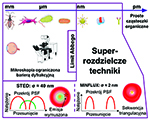Can the laws of physics be circumvented? On methods of super-resolution fluorescence microscopy
DOI:
https://doi.org/10.18388/pb.2021_527Abstract
Biological sciences are increasingly uncovering the foundations of life in greater detail, made possible by the development of research methods enabling exploration at the nanometer scale. Optical microscopy, a field with a significant contribution to current knowledge, is inherently limited by the Abbe limit, stemming from the fundamental wave properties of light. Through the efforts of scientists, this limit can be circumvented, as evidenced by STED and MINFLUX techniques. STED allows imaging with a resolution down to 40 nm, while MINFLUX enables resolution as fine as 2 nm. Both techniques require labelling of biological molecular targets with fluorescent markers and enable imaging in living cells, facilitating the study of dynamic biological processes. This article provides an introduction to super-resolution techniques STED and MINFLUX, demonstrating their utility through the example of studying kinesin movement along microtubules using the MINFLUX technique.

Published
License
Copyright (c) 2024 Adrian Rüfli

This work is licensed under a Creative Commons Attribution 4.0 International License.
All journal contents are distributed under the Creative Commons Attribution-ShareAlike 4.0 International (CC BY-SA 4.0) license. Everybody may use the content following terms: Attribution — You must give appropriate credit, provide a link to the license, and indicate if changes were made, ShareAlike — If you remix, transform, or build upon the material, you must distribute your contributions under the same license as the original. There are no additional restrictions — You may not apply legal terms or technological measures that legally restrict others from doing anything the license permits.
Copyright for all published papers © stays with the authors.
Copyright for the journal: © Polish Biochemical Society.



